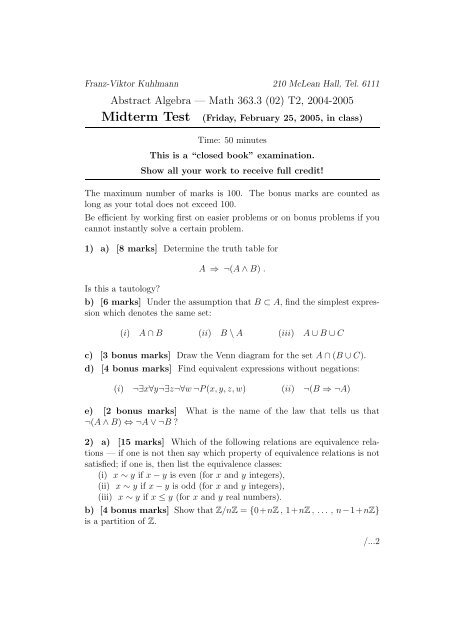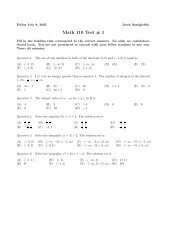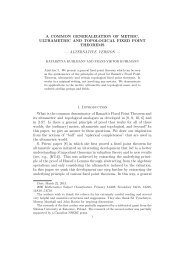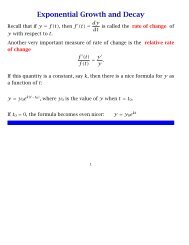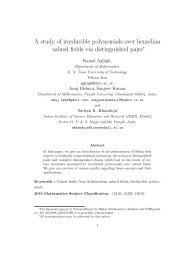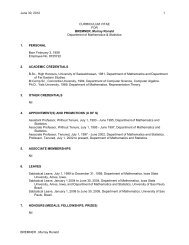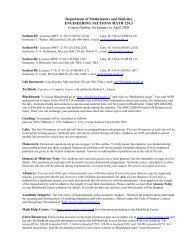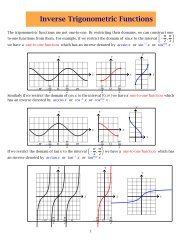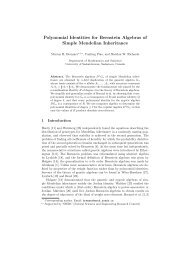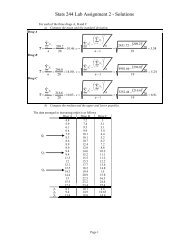Midterm Test
Midterm Test
Midterm Test
You also want an ePaper? Increase the reach of your titles
YUMPU automatically turns print PDFs into web optimized ePapers that Google loves.
Franz-Viktor Kuhlmann 210 McLean Hall, Tel. 6111<br />
Abstract Algebra — Math 363.3 (02) T2, 2004-2005<br />
<strong>Midterm</strong> <strong>Test</strong> (Friday, February 25, 2005, in class)<br />
Time: 50 minutes<br />
This is a “closed book” examination.<br />
Show all your work to receive full credit!<br />
The maximum number of marks is 100. The bonus marks are counted as<br />
long as your total does not exceed 100.<br />
Be efficient by working first on easier problems or on bonus problems if you<br />
cannot instantly solve a certain problem.<br />
1) a) [8 marks] Determine the truth table for<br />
Is this a tautology?<br />
A ⇒ ¬(A ∧ B) .<br />
b) [6 marks] Under the assumption that B ⊂ A, find the simplest expression<br />
which denotes the same set:<br />
(i) A ∩ B (ii) B \ A (iii) A ∪ B ∪ C<br />
c) [3 bonus marks] Draw the Venn diagram for the set A ∩ (B ∪ C).<br />
d) [4 bonus marks] Find equivalent expressions without negations:<br />
(i) ¬∃x∀y¬∃z¬∀w ¬P (x, y, z, w) (ii) ¬(B ⇒ ¬A)<br />
e) [2 bonus marks] What is the name of the law that tells us that<br />
¬(A ∧ B) ⇔ ¬A ∨ ¬B ?<br />
2) a) [15 marks] Which of the following relations are equivalence relations<br />
— if one is not then say which property of equivalence relations is not<br />
satisfied; if one is, then list the equivalence classes:<br />
(i) x ∼ y if x − y is even (for x and y integers),<br />
(ii) x ∼ y if x − y is odd (for x and y integers),<br />
(iii) x ∼ y if x ≤ y (for x and y real numbers).<br />
b) [4 bonus marks] Show that Z/nZ = {0+nZ , 1+nZ , . . . , n−1+nZ}<br />
is a partition of Z.<br />
/...2
3) [10 marks] Is there a bijection from a set with 57 elements to a set with<br />
58 elements? Is there a bijection from a set with 58 elements to a set with 57<br />
elements? Is there an invertible mapping from a set with 58 elements to a set<br />
with 57 elements? Is there an onto mapping from a set with 58 elements to a<br />
set with 57 elements? Is there an onto mapping from a set with 57 elements<br />
to a set with 58 elements? Explain.<br />
4) [4 bonus marks] Prove that in every group, the inverse of an element<br />
is uniquely determined.<br />
5) Let (G, ·) be a (not necessarily abelian!) group, and let a, b, c, d be<br />
elements of G.<br />
a) [6 marks] Prove: if ca = cb, then a = b. Why does this not hold for<br />
the usual multiplication on Q? What modification is necessary to obtain a<br />
group with multiplication from the set Q?<br />
b) [4 marks] Determine the inverse of a 2 b −3 ac 5 d.<br />
c) [3 bonus marks] Solve for x:<br />
abcbcxd = ac .<br />
Write the solution in the simplest possible form.<br />
6) a) [6 marks] State the “One Step Subgroup Criterion”.<br />
b) [12 marks] Use the One Step Subgroup Criterion to prove that in every<br />
dihedral group Dn, the subset of rotations forms a subgroup. Show that it is<br />
Abelian. How many elements does it have? Show that it is cyclic and name<br />
at least one generator.<br />
7) a) [5 marks] What is U(n)?<br />
b) [5 marks] Determine the elements of U(9). What is the order of this<br />
group?<br />
c) [5 marks] Determine the Cayley table of U(9).<br />
d) [4 marks] Is 2 an element of U(9)? If yes, determine the order of 2 in<br />
U(n).<br />
e) [3 marks] Determine the order of 2 in (Z/9Z, +).<br />
f) [4 marks] Is U(9) cyclic? If yes, name a generator.<br />
g) [3 marks] Determine the inverse of 2 in U(9).<br />
h) [4 marks] Prove: in a cyclic group 〈a〉 of finite order n, the inverse of<br />
the element a k is the element a n−k .<br />
* * * THE END * * *


